Monday, 19 May 2008, Épernay to Verdun—Champagne and chocolate
(Written 20 May 2008)
Breakfast was much less eventful; I kept the room key in my pocket the whole time.
We checked out of the hotel, put our luggage in storage at reception, and set off once again the tourism office, this time to look at a photo exhibit they were featuring and to reserve our places for the minibus tour of a champagne vinyard a week hence. The photo exihibit featured images of lines of various sorts; my favorite was a photo of part of the valley of the Marine in which both hillside and bottomland were plowed, showing the amazingly abrupt boundary between chalky hillside soil and rich, dark bottomland. The photos looked at and the reservation made, we walked accross the street to do the tour at Moët et Chandon.
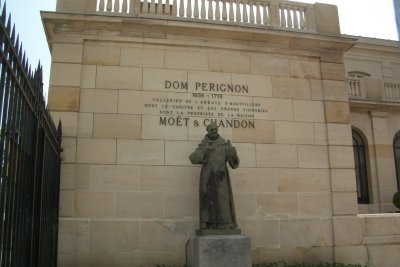 Dom Perignon champagne is M&C's superpremium product, and this statue of the Dom himself graces their courtyard. He was the monk who invented champagne, at least in a commercially viable sense, and who successfully marketed it nationally and saw to it that the local winegrowers increased in prosperity as a result. His monastery (and everybody else in the region) had long made a still wine of no great distinction, which was distributed and sold in barrels. This was all pre-Pasteur, and nobody had ever taken note that, when the wine was put into the barrels, the yeasts had not completed the fermentation process; they had simply been brought to a halt by the cold weather. Dom Perignon, in his quest for a way to preserve wine longer, and thus improve his distribution options, was the first to start putting it in tightly corked and sealed bottles. When the weather warmed up, everybody else's wine resumed and completed fermentation unnoticed (the barrels weren't pressure-tight), whereas in Dom Perignon's cellar, some of the bottles exploded and others shot their corks to the ceiling, foaming over with a slightly carbonated wine that was, . . . hmmm, you know, . . . not bad! Dom Perignon looked for stronger bottles and found them in England, where glassmakers were forbidden to burn wood (which was needed for ship-building) and used coal instead, producing stronger, higher-temperature glass. Soon incompletely fermented wine was being deliberately bottled and tightly corked, and the rest is bubbly history.
Dom Perignon champagne is M&C's superpremium product, and this statue of the Dom himself graces their courtyard. He was the monk who invented champagne, at least in a commercially viable sense, and who successfully marketed it nationally and saw to it that the local winegrowers increased in prosperity as a result. His monastery (and everybody else in the region) had long made a still wine of no great distinction, which was distributed and sold in barrels. This was all pre-Pasteur, and nobody had ever taken note that, when the wine was put into the barrels, the yeasts had not completed the fermentation process; they had simply been brought to a halt by the cold weather. Dom Perignon, in his quest for a way to preserve wine longer, and thus improve his distribution options, was the first to start putting it in tightly corked and sealed bottles. When the weather warmed up, everybody else's wine resumed and completed fermentation unnoticed (the barrels weren't pressure-tight), whereas in Dom Perignon's cellar, some of the bottles exploded and others shot their corks to the ceiling, foaming over with a slightly carbonated wine that was, . . . hmmm, you know, . . . not bad! Dom Perignon looked for stronger bottles and found them in England, where glassmakers were forbidden to burn wood (which was needed for ship-building) and used coal instead, producing stronger, higher-temperature glass. Soon incompletely fermented wine was being deliberately bottled and tightly corked, and the rest is bubbly history.
The M&C tour was longer than De Castellane's, but actually less complete. We didn't see the bottling or labeling operations, and the explanations of the whole champagne method was less clear, but we walked through a portion of their (28 km of!) cellars, and we had a long chat with the guide in the tasting room afterward. One difference between the De Castellane and M&C tours was that the former explained the use of the "bidule" and the latter did not mention it. Back in 1988, we toured three or four champagne cellars and never heard of the bidule, so it may be an innovation since then, or perhaps it was in use but no one mentioned it, and maybe now everyone uses it but M&C doesnt' advertise the fact (it seems so much less "artisanal"), or maybe some use it and some don't. Anyway, a unique step in champagne making, not necessary for still wines, is riddling and degorgement. Once the yeasts have finished their secondary fermentation (actually the third fermentation for the wine, because it undergoes a second "malolactic" bacterial fermentation after the first yeast fermentation) in the bottle, producing the fizz, the dead yeast are still in there and settle to the bottom of the bottle, actually the side, since the bottles are stored on their sides. Riddling is the process, over the course of a month, of tapping and turning each bottle a little each day, while raising it gradually from the horizontal position to the vertical, standing on its neck. (Back before reliably strong pressure bottles, riddlers were sometimes injured or blinded when that little daily turn-tap caused a bottle to explode.) The bottles were originally stuck into piles of sand, then into specially angled holes cut into a wooden "riddling rack," then into individual bottle-sockets of automated riddlers, and now into enormous hundred-bottle crates that are vibrated, rocked, and gradually raised upright—a modern riddling machine can riddle a crate of bottles in a day rather than the month it took by hand. It's actually the time the champagne spends in contact with those sediments, both in the barrel before bottling and then in the bottle after secondary fermentation, that give the wine that "toasty" flavor that David so prizes.
After the riddling, when the bottles were standing on their heads, with all the dead yeasts collected in a little pellet down against the cork, came the tricky degorgement step. In the old days, expert degorgers removed that pellet "on the fly." Working with their hands and the bottle inside a barrel section (as we would use a glove box or fume hood), they would deftly turn each bottle upright and quickly pop the cork. The gas bubble inside would push the sediments out with the cork, and the degorger would clamp a thumb over the neck to prevent loss of any more pressure (a strong thumb—the pressure in the bottle is about 6 kilos). Then he (or an assistant) would somehow add the "dosage" (a mixture of a little sugar and some wine from a previous year that rounded out the desired flavor) and recorked the bottle, permanently this time. The process could take a couple of minutes.
Nowadays, it's automated and is done start to finish in about 20 seconds—the neck of each bottle is dipped in a very low-temperature bath that freezes the pellet to the cork. The cork is popped, the frozen pellet ejected, the bottled dosed, and the new cork inserted by machine. By both methods, the pellets and any accompanying liquid are recovered and used in making eau de vie.
But to improve the degorgement process, the bidule was invented. It's a little plastic thimble that just fits into the neck of the bottle. When the champagne is bottled, the bidule is inserted after it, closed end up, and the cork after that. As a result, when the bottle is riddled, all the sediment settles into the bidule, no longer touching the walls of the bottle, so it can be frozen and popped out, cork, bidule, and all, very cleanly. De Castellane uses bidules, and I wonder whether Moët does as well.
In our talk with the tour guide in the tasting room, we got some questions answered, especially about M&C champagnes sold in the U.S. Their flagship product is the Brut Imperial ("brut" means very, very dry), named in honor of Napoleon Bonaparte, who was a good buddy of Mr. Moët (grandson of the founder and whose daughter married Mr. Chandon). It's sold in virtually every country in the world except the United States, where M&C markets "White Star" instead. David was absolutely scandalized to learn, back in 1988, that White Star is just like Brut Imperial except that they add more sugar for the American market ("but only about 1 gram per glass" the guide assured us). M&C don't wan't to confuse American customers by marketing both White Star and Brut Imperial in the U.S., and they're sick of being confusedwith White Star cruise lines and of having just one product in their line that doesn't include the word "Imperial," so soon they will change the name of White Star to "Imperial Moët," but it will still be sweeter. White Star is available in France only in the M&C gift shop in Épernay and there only by special dispensation. They used to have to import White Star that they had already exported to New York, just to be able to pour it in the tasting room. What I want to know is how much total sugar a glass of Brut Imperial contains. A gram of sugar is about 1/4 tsp, and that seems like alot, compared with the size of a glass of very dry champagne.
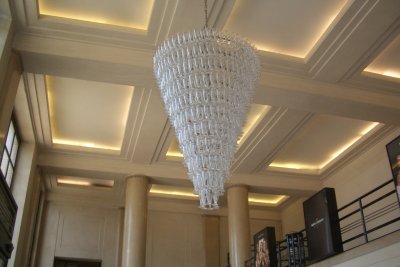
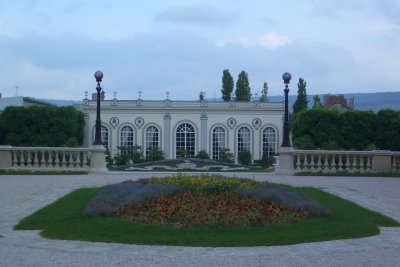 This crystal chandelier made of (crystal) wine glasses (specifically champagne flutes) hangs in the M&C lobby. and this charming little betrellised "trianon," located in the courtyard of the building across the Avenue de Champagne, is the residence Mr. Moët built for use by his buddy Napoleon, when he was in town.
This crystal chandelier made of (crystal) wine glasses (specifically champagne flutes) hangs in the M&C lobby. and this charming little betrellised "trianon," located in the courtyard of the building across the Avenue de Champagne, is the residence Mr. Moët built for use by his buddy Napoleon, when he was in town.
After the tour, we grabbed a little lunch at Le Centrale, near the town hall. David had a "salade montagnard" (greens, tomato, lardons, potatoes, and a poached egg); I had the "salade centrale" (greens, tomatoes, potatoes, chicken livers, fois gras, and magret, i.e., duck-breast ham). Both were good, but the chicken livers were a little overcooked and the vinaigrette uncharacteristically mild (I thought it bland, but David liked it okay). Then on to reclaim our luggage at the hotel, extract our car from the underground garage, and head for our afternoon activity—touring a chocolate factory!
Chocolat Thibauld is located in Pierry, ca. 4 km south of Épernay, in a rather industrial-looking building behind a LeClerc hypermarket and strip mall, between a building-materials company and a garden center. Inside, though, the shop looks just as festive and delicious as the ones you see in shop windows in town, and it smells delicious! That's because, in the room directly behind the little shop, the chocolates are being made. As far as we can tell, it's a mom and pop operation—a rather young couple and a teen-age apprentice who may or may not be the son. Pop wasn't there, but mom gave us a great tour. It's all done in a single room, about the size of a two-car garage (though I'm sure there's another room in back for storage, extra refrigerators, etc. The tour included an overview (aided by large photos on the wall of the various steps) of the chocolate-making process, from harvest of the cocoa pods from the tree through "fermentation" (actually more of a maceration), roasting, grinding, pressing (which separates the beans into their two components, cocoa butter and cocoa powder), blending (in which those components are blended in various proportions with sugar and, optionally, dried milk), etc., but madame made clear that she and her operation did none of these things. Their raw material was slabs of already blended chocolate, dark, milk, or white. She emphasized that the percentage on the package is not, as most people believe, the percentage of cocoa powder in the product; it is the percentage of total cocoa, i.e. cocoa powder plus cocoa butter. So in chocolate at 65%, the other 35% consists of sugar and/or milk. She orders, from her supplier, chocolate at different precentages for different uses.
In the room we toured are four water-jacketed kettles, each holding perhaps 10 gallons of chocolate—one each for dark, milk, and white chocolate and a spare for whatever they're making a lot of at the moment. Each of the kettles is used to "temper" the chocolate, i.e., to heat it to 50 degrees C, then cool it to 28 degrees C, then warm it back up to 32 degrees C, which is the "working temperature," all with continuous automatic stirring. This process ensures that the components of the chocolate are properly blended and will be bright and glossy when hardened, and it retards the "blooming" process that makes chocolate turn powdery white when stored too long in warm weather.
The speciality of the house, and by far the greatest volume of what they make, is liqueur-filled, bite-size, chocolate champagne corks, so they have a fifth kettle for cooking up sugar syrup spiked with fine de champagne, marc de champagne, or ratafia. Originally all the molds were metal, so the two halves just clamped together and were used as is, but now metal molds are no longer made—she uses reusable (but much shorter-lived) plastic molds, which are so flimsy they must be supported by sturdy metal frames. She demonstrated the process to us: first she put lower-half plastic mold (a sheet of 56 "back halves" of small champagne corks in one side of a hinged metal frame) and the upper half (a corresponding sheet of "front halves," each with a dimple that would form the indentation through which the cork would be filled) into the other side. She ran one half under a little dispenser set to dispense an exact number of grams of chocolate into each cork-half. Then she hinged the two mold halves together, clamped them in place, and turned them over and over to distribute the chocolate over the entire inside surface of each 3D cork shape, all while pressing each side, corner, and edge of the mold in turn onto a little vibrator table, to ensure that the chocolate penetrated every nook and crevice of the mold and that bubbles were shaken loose to rejoin the void in the center of each cork. Then she turned to a machine that held six such mold assemblies and turned them continuously in all directions, round and round, up and down, and edgewise, to keep chocolate from settling to one side or the other of the mold before it hardened. While is turned, she quickly removed a finished mold, and inserted the freshly made one it its place (the arms of the machine are numbered, so that the chocolate maker can keep track of which molds have just been put on the machine and which can be taken off). The removed mold is transferred to the fridge overnight.
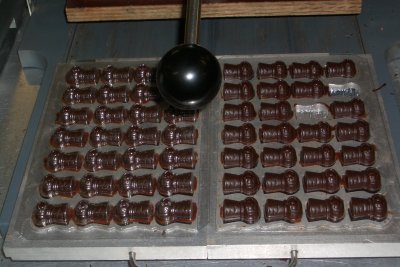 The next morning, the finished mold is taken from the fridge and opened—the metal frame is unclamped and opened, and the top plastic sheet carefully removed for cleaning and reuse. The new little hollow chocolate corks, still lying in the "back half" of the plastic mold are carefully inspected for defects—anyplace they might leak, e.g., if a bubble clung to the mold and formed a gap in the chocolate shell. Of the sheet we saw, two were rejected (to be remelted and be part of the next batch). Those that pass muster, still in their plastic mold, are passed under a plate, studded with little spikes, that is lowered by means of a lever to pierce each cork precisely in the center of its little indentation. The next step is to pass them under another dispenser that releases an, again precisely measured, quantity of cooled liqueur-spiked sugar syrup in through the hole in each cork, to fill the void in the center. The mold is then slid under a perforated plate through the holes of which melted chocolate can pass to fill the little indentations, sealing the chocolates. After another night in the fridge (during which sugar crystalizes out of the syrup to form a crisp coating on the inside of each chocolate that prevents the liquid from softening the chocolate shell from the inside), the corks are popped out of their mold and placed in the slots of a belt that feeds them into a wonderful antique cast-iron machine that neatly wraps each one in foil (a different color for each flavor), tightly enough to show the shape of the cork. We were offered samples, which were delicious. On the way out, we bought more chocolates, these in the shape of snails and filled with chocolate-caramel cream.
The next morning, the finished mold is taken from the fridge and opened—the metal frame is unclamped and opened, and the top plastic sheet carefully removed for cleaning and reuse. The new little hollow chocolate corks, still lying in the "back half" of the plastic mold are carefully inspected for defects—anyplace they might leak, e.g., if a bubble clung to the mold and formed a gap in the chocolate shell. Of the sheet we saw, two were rejected (to be remelted and be part of the next batch). Those that pass muster, still in their plastic mold, are passed under a plate, studded with little spikes, that is lowered by means of a lever to pierce each cork precisely in the center of its little indentation. The next step is to pass them under another dispenser that releases an, again precisely measured, quantity of cooled liqueur-spiked sugar syrup in through the hole in each cork, to fill the void in the center. The mold is then slid under a perforated plate through the holes of which melted chocolate can pass to fill the little indentations, sealing the chocolates. After another night in the fridge (during which sugar crystalizes out of the syrup to form a crisp coating on the inside of each chocolate that prevents the liquid from softening the chocolate shell from the inside), the corks are popped out of their mold and placed in the slots of a belt that feeds them into a wonderful antique cast-iron machine that neatly wraps each one in foil (a different color for each flavor), tightly enough to show the shape of the cork. We were offered samples, which were delicious. On the way out, we bought more chocolates, these in the shape of snails and filled with chocolate-caramel cream.
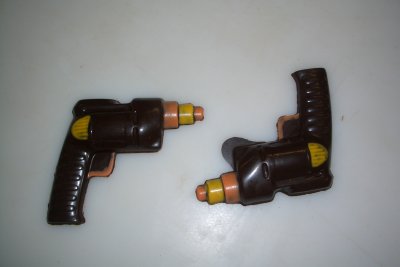
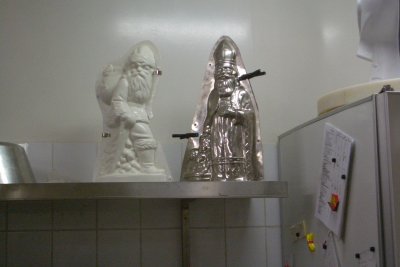 In addition to champagne corks, they make a huge variety of other shapes (some obscene!). Father's day is coming up, so they were making a big batch of these terrific chocolate electric drills we (also hand saws, hammers, measuring sticks, soccer and rugby balls, etc.). To add the colors, they tint white chocolate and paint the insides of the molds with it before adding the rest of the chocolate. For other occasions they make all kinds of shapes, some of them up to three feet high. For a six-inch pascal lamb, they pour chocolate into the individual mold and pour it right back out again, then repeat once or twice more after it sets. They have to build up the shape in layers because they have no way to "auto-gyrate" these open molds automatically. For a three-foot-high easter chicken or Santa Clause, they may make five or six layers.
In addition to champagne corks, they make a huge variety of other shapes (some obscene!). Father's day is coming up, so they were making a big batch of these terrific chocolate electric drills we (also hand saws, hammers, measuring sticks, soccer and rugby balls, etc.). To add the colors, they tint white chocolate and paint the insides of the molds with it before adding the rest of the chocolate. For other occasions they make all kinds of shapes, some of them up to three feet high. For a six-inch pascal lamb, they pour chocolate into the individual mold and pour it right back out again, then repeat once or twice more after it sets. They have to build up the shape in layers because they have no way to "auto-gyrate" these open molds automatically. For a three-foot-high easter chicken or Santa Clause, they may make five or six layers.
(Written 21 May 2008)
Then, alas, it was time to leave Épernay and to hit the road to Verdun, ca. 100 km away. Unfortunately, as we were approaching Verdun a couple of hours later, David realized he didn't have his Tilley hat. He had it when we left the restaurant after lunch, but didn't wear it into the chocolate place. Drat. He was wearing it principally because his good French-bought panama disappeared under mysterious circumstances in the hotel in Houston last summer, so now he was entirely hatless.
In Verdun, we located our hotel, the St. Paul, on the second turn around giant one-way rotary that circles the middle of town, despite the construction that kept shunting us off into detours. Miraculously, we got a parking space literally at the door, and paying for the last couple of hours before 7 p.m. got us the space until 9 a.m. the next morning (at which point David moved the car around the corner into the little free parking lot recommended by the hotel desk, next to the synagogue).
We had dinner at Le Coq Hardi, a venerable establishment right in the center of the town, on the quai next to the Meuse. We both ate the same things.
Amuse-bouche: a little glass mug full of thick spicy chilled tomato soup topped with a little dollop of sour cream and two whole carraway seeds, a strip of crisp puff pastry topped with almonds and sesame seeds, and a little bamboo skewer holding three little balls of Charentais melon. Yum. I heard the waiter tell another client that the soup was seasoned with authentic Tabasco sauce.
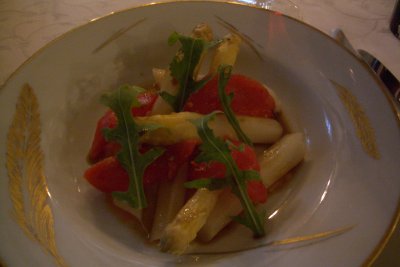 First course: Warm white asparagus topped with a scattering of very peppery olive-oil-dressed arugula leaves and "petals" of confit tomatoes. Delicious.
First course: Warm white asparagus topped with a scattering of very peppery olive-oil-dressed arugula leaves and "petals" of confit tomatoes. Delicious.
The bread was also delicious and was served with especially good, very yellow butter in a covered silver dish. I lifted the lid and used the butter knife to cut a slice, which I transferred to my bread plate, and replaced the cover. A moment later, David lifted the cover to find . . . nothing! "Okay," he said, knowing my fondness for butter, "what did you do with it?" "Ah," I said, "replace the cover." I tapped it with my magic table knife and lifted the lid again to reveal the tall cylinder of butter. The inner dish containing the butter had been stuck inside the domed lid!
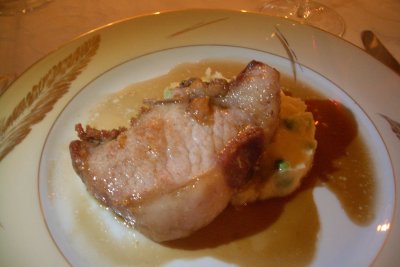 Second course: A thick pork chop (from a special black Gascon pig), served pink inside, over a scoop of delicious mashed potatoes studded with raw sweet peas. Excellent.
Second course: A thick pork chop (from a special black Gascon pig), served pink inside, over a scoop of delicious mashed potatoes studded with raw sweet peas. Excellent.
Third course: A preset cheese assortment consisting of a wedge of Brie produced in the Meuse region but aged and "finished" in Meaux and a little wedge of a local black-pepper-coated chevre. Not such a much. Not an interesting Brie and a nondescript chevre coated with way too much pepper.
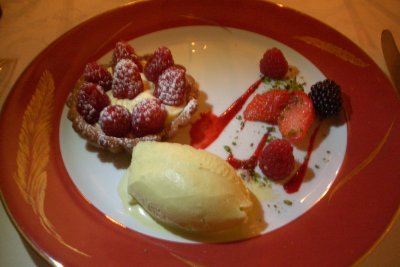 Dessert: Fresh raspberry tart with pistachio ice cream.
Dessert: Fresh raspberry tart with pistachio ice cream.
On the way home from the restaurant, David finally realized where he had left his Tilley hat, which he had missed in the course of the afternoon— at the Ibis hotel in Épernay, when we went back for our luggage. This morning I was able to call them, and yes, they had the hat. We'll be back in Épernay on 27 May for a winery tour, so we'll pick it up then.
previous entry
List of Entries
next entry
 Dom Perignon champagne is M&C's superpremium product, and this statue of the Dom himself graces their courtyard. He was the monk who invented champagne, at least in a commercially viable sense, and who successfully marketed it nationally and saw to it that the local winegrowers increased in prosperity as a result. His monastery (and everybody else in the region) had long made a still wine of no great distinction, which was distributed and sold in barrels. This was all pre-Pasteur, and nobody had ever taken note that, when the wine was put into the barrels, the yeasts had not completed the fermentation process; they had simply been brought to a halt by the cold weather. Dom Perignon, in his quest for a way to preserve wine longer, and thus improve his distribution options, was the first to start putting it in tightly corked and sealed bottles. When the weather warmed up, everybody else's wine resumed and completed fermentation unnoticed (the barrels weren't pressure-tight), whereas in Dom Perignon's cellar, some of the bottles exploded and others shot their corks to the ceiling, foaming over with a slightly carbonated wine that was, . . . hmmm, you know, . . . not bad! Dom Perignon looked for stronger bottles and found them in England, where glassmakers were forbidden to burn wood (which was needed for ship-building) and used coal instead, producing stronger, higher-temperature glass. Soon incompletely fermented wine was being deliberately bottled and tightly corked, and the rest is bubbly history.
Dom Perignon champagne is M&C's superpremium product, and this statue of the Dom himself graces their courtyard. He was the monk who invented champagne, at least in a commercially viable sense, and who successfully marketed it nationally and saw to it that the local winegrowers increased in prosperity as a result. His monastery (and everybody else in the region) had long made a still wine of no great distinction, which was distributed and sold in barrels. This was all pre-Pasteur, and nobody had ever taken note that, when the wine was put into the barrels, the yeasts had not completed the fermentation process; they had simply been brought to a halt by the cold weather. Dom Perignon, in his quest for a way to preserve wine longer, and thus improve his distribution options, was the first to start putting it in tightly corked and sealed bottles. When the weather warmed up, everybody else's wine resumed and completed fermentation unnoticed (the barrels weren't pressure-tight), whereas in Dom Perignon's cellar, some of the bottles exploded and others shot their corks to the ceiling, foaming over with a slightly carbonated wine that was, . . . hmmm, you know, . . . not bad! Dom Perignon looked for stronger bottles and found them in England, where glassmakers were forbidden to burn wood (which was needed for ship-building) and used coal instead, producing stronger, higher-temperature glass. Soon incompletely fermented wine was being deliberately bottled and tightly corked, and the rest is bubbly history.
 This crystal chandelier made of (crystal) wine glasses (specifically champagne flutes) hangs in the M&C lobby. and this charming little betrellised "trianon," located in the courtyard of the building across the Avenue de Champagne, is the residence Mr. Moët built for use by his buddy Napoleon, when he was in town.
This crystal chandelier made of (crystal) wine glasses (specifically champagne flutes) hangs in the M&C lobby. and this charming little betrellised "trianon," located in the courtyard of the building across the Avenue de Champagne, is the residence Mr. Moët built for use by his buddy Napoleon, when he was in town. The next morning, the finished mold is taken from the fridge and opened—the metal frame is unclamped and opened, and the top plastic sheet carefully removed for cleaning and reuse. The new little hollow chocolate corks, still lying in the "back half" of the plastic mold are carefully inspected for defects—anyplace they might leak, e.g., if a bubble clung to the mold and formed a gap in the chocolate shell. Of the sheet we saw, two were rejected (to be remelted and be part of the next batch). Those that pass muster, still in their plastic mold, are passed under a plate, studded with little spikes, that is lowered by means of a lever to pierce each cork precisely in the center of its little indentation. The next step is to pass them under another dispenser that releases an, again precisely measured, quantity of cooled liqueur-spiked sugar syrup in through the hole in each cork, to fill the void in the center. The mold is then slid under a perforated plate through the holes of which melted chocolate can pass to fill the little indentations, sealing the chocolates. After another night in the fridge (during which sugar crystalizes out of the syrup to form a crisp coating on the inside of each chocolate that prevents the liquid from softening the chocolate shell from the inside), the corks are popped out of their mold and placed in the slots of a belt that feeds them into a wonderful antique cast-iron machine that neatly wraps each one in foil (a different color for each flavor), tightly enough to show the shape of the cork. We were offered samples, which were delicious. On the way out, we bought more chocolates, these in the shape of snails and filled with chocolate-caramel cream.
The next morning, the finished mold is taken from the fridge and opened—the metal frame is unclamped and opened, and the top plastic sheet carefully removed for cleaning and reuse. The new little hollow chocolate corks, still lying in the "back half" of the plastic mold are carefully inspected for defects—anyplace they might leak, e.g., if a bubble clung to the mold and formed a gap in the chocolate shell. Of the sheet we saw, two were rejected (to be remelted and be part of the next batch). Those that pass muster, still in their plastic mold, are passed under a plate, studded with little spikes, that is lowered by means of a lever to pierce each cork precisely in the center of its little indentation. The next step is to pass them under another dispenser that releases an, again precisely measured, quantity of cooled liqueur-spiked sugar syrup in through the hole in each cork, to fill the void in the center. The mold is then slid under a perforated plate through the holes of which melted chocolate can pass to fill the little indentations, sealing the chocolates. After another night in the fridge (during which sugar crystalizes out of the syrup to form a crisp coating on the inside of each chocolate that prevents the liquid from softening the chocolate shell from the inside), the corks are popped out of their mold and placed in the slots of a belt that feeds them into a wonderful antique cast-iron machine that neatly wraps each one in foil (a different color for each flavor), tightly enough to show the shape of the cork. We were offered samples, which were delicious. On the way out, we bought more chocolates, these in the shape of snails and filled with chocolate-caramel cream.
 In addition to champagne corks, they make a huge variety of other shapes (some obscene!). Father's day is coming up, so they were making a big batch of these terrific chocolate electric drills we (also hand saws, hammers, measuring sticks, soccer and rugby balls, etc.). To add the colors, they tint white chocolate and paint the insides of the molds with it before adding the rest of the chocolate. For other occasions they make all kinds of shapes, some of them up to three feet high. For a six-inch pascal lamb, they pour chocolate into the individual mold and pour it right back out again, then repeat once or twice more after it sets. They have to build up the shape in layers because they have no way to "auto-gyrate" these open molds automatically. For a three-foot-high easter chicken or Santa Clause, they may make five or six layers.
In addition to champagne corks, they make a huge variety of other shapes (some obscene!). Father's day is coming up, so they were making a big batch of these terrific chocolate electric drills we (also hand saws, hammers, measuring sticks, soccer and rugby balls, etc.). To add the colors, they tint white chocolate and paint the insides of the molds with it before adding the rest of the chocolate. For other occasions they make all kinds of shapes, some of them up to three feet high. For a six-inch pascal lamb, they pour chocolate into the individual mold and pour it right back out again, then repeat once or twice more after it sets. They have to build up the shape in layers because they have no way to "auto-gyrate" these open molds automatically. For a three-foot-high easter chicken or Santa Clause, they may make five or six layers. First course: Warm white asparagus topped with a scattering of very peppery olive-oil-dressed arugula leaves and "petals" of confit tomatoes. Delicious.
First course: Warm white asparagus topped with a scattering of very peppery olive-oil-dressed arugula leaves and "petals" of confit tomatoes. Delicious. Second course: A thick pork chop (from a special black Gascon pig), served pink inside, over a scoop of delicious mashed potatoes studded with raw sweet peas. Excellent.
Second course: A thick pork chop (from a special black Gascon pig), served pink inside, over a scoop of delicious mashed potatoes studded with raw sweet peas. Excellent. Dessert: Fresh raspberry tart with pistachio ice cream.
Dessert: Fresh raspberry tart with pistachio ice cream.